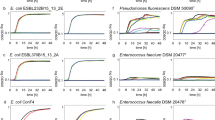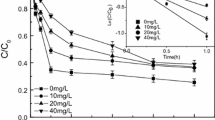Abstract
Nitrate is linked to chronic human illness and to a variety of environmental problems, and continues to be a contaminant of concern in soils and natural waters. Improved methods for nitrate abatement, thus, are still needed. The purpose of this study was to assess the potential for redox-modified, iron-bearing clay minerals to act as nitrate decontamination agents in natural environments. The model clay mineral tested was ferruginous smectite (sample SWa-1) exchanged with either sodium (Na+) or polydiallyldimethylammonium chloride (poly-DADMAC). Structural iron (Fe) in SWa-1 was in either the oxidized or reduced state. Little nitrate uptake was observed in the Na+-SWa-1, which was attributed to coulombic repulsion between the basal surfaces of the smectite and the nitrate anion. The addition of the DADMAC to the SWa-1 reversed the electrostatic charge manifested at the smectite surface from negative to positive, as measured by the zeta (ζ) potential. The positively charged poly-DADMAC-SWa-1 yielded high nitrate uptake due to coulombic attraction in both the oxidized and reduced states of the Fe in the SWa-1. The presence of reduced structural Fe(II) in the positively charged poly-DADMAC-SWa-1 enabled a chemical reduction reaction with the nitrate to produce nitrite. The amounts of nitrite found in solution, however, failed to account for all of the Fe(II) oxidized, so other N reduction products may also have formed or perhaps nitrite was also present in the adsorbed phase. The effects of other complexities, such as polymer configuration at the surface, also need further investigation. The results do clearly establish abiotic nitrate reduction to nitrite and possibly other reduction products. The combination of bacterial activity in soils and sediments, which is known to reduce structural Fe in smectites, and the abundance of organic cations in soil organic matter creates an environment where reversed-charge smectite could exist in nature. This represents a potentially effective system for mitigating harmful effects of nitrate in soils, sediments, groundwater, and surface water.
Similar content being viewed by others
References
Alowitz, M.J. and Scherer, M.M. (2002) Kinetics of nitrate, nitrite, and Cr(VI) reduction by iron metal. Environmental Science & Technology, 36, 299–306.
Baggs, E.M. (2011) Soil microbial sources of nitrous oxide: Recent advances in knowledge, emerging challenges and future direction. Current Opinion in Environmental Sustainability, 3, 321–327.
Bleiman, N. and Mishael, Y.G. (2010) Selenium removal from drinking water by adsorption to chitosan-clay composites and oxides: Batch and columns tests. Journal of Hazardous Materials, 183, 590–595.
Breen, C. (1999) The characterisation and use of polycation-exchanged bentonites. Applied Clay Science, 15, 187–219.
Breen, C. and Watson, R. (1998) Polycation-exchanged clays as sorbents for organic pollutants: Influence of layer charge on pollutant sorption capacity. Journal of Colloid and Interface Science, 208, 422–429.
Burgin, A.J. and Hamilton, S.K. (2007) Have we overemphasized the role of denitrification in aquatic ecosystems? A review of nitrate removal pathways. Frontiers in Ecology and the Environment, 5, 89–96.
Camargo, J.A. and Alonso, A. (2006) Ecological and toxicological effects of inorganic nitrogen pollution in aquatic ecosystems: A global assessment. Environment International, 32, 831–849.
Cervini-Silva, J., Wu, J., Stucki, J.W., and Larson, R.A. (2000) Adsorption kinetics of pentachloroethane in iron-bearing smectites. Clays and Clay Minerals, 48, 132–138.
Chang, M.Y. and Juang, R.S. (2004) Adsorption of tannic acid, humic acid, and dyes from water using the composite of chitosan and activated clay. Journal of Colloid and Interface Science, 278, 18–25.
Chen, S.Z., Low, P.F., and Roth, C.B. (1987) Relation between potassium fixation and the oxidation-state of octahedral iron. Soil Science Society of America Journal, 51, 82–86.
Churchman, G.J. (2002a) Formation of complexes between bentonite and different cationic polyelectrolytes and their use as sorbents for non-ionic and anionic pollutants. Applied Clay Science, 21, 177–189.
Churchman, G.J. (2002b) Formation of complexes between bentonite and different cationic polyelectrolytes and their use as sorbents for non-ionic and anionic pollutants. Applied Clay Science, 21, 177–189.
Claesson, P.M., Poptoshev, E., Blomberg, E., and Dedinaite, A. (2005) Polyelectrolyte-mediated surface interactions. Advances in Colloid and Interface Science, 114-115, 173–187.
Colthup, N.B. (1950) Spectra-structure correlation in the infrared region. Journal of the Optical Society of America, 40, 397–400.
Darder, M., Colilla, M., and Ruiz-Hitzky, E. (2005) Chitosan-clay nanocomposites: Application as electrochemical sensors. Applied Clay Science, 28, 199–208.
Darder, M., Lopez-Blanco, M., Aranda, P., Aznar, A.J., Bravo, J., and Ruiz-Hitzky, E. (2006) Microfibrous chitosansepiolite nanocomposites. Chemistry of Materials, 18, 1602–1610.
Davidson, E.A., Chorover, J., and Dail, D.B. (2003) A mechanism of abiotic immobilization of nitrate in forest ecosystems: The ferrous wheel hypothesis. Global Change Biology, 9, 228–236.
Devlin, J.F., Eedy, R., and Butler, B.J. (2000) The effects of electron donor and granular iron on nitrate transformation rates in sediments from a municipal water supply aquifer. Journal of Contaminant Hydrology, 46, 81–97.
Durand-Piana, G., Lafuma, F., and Audebert, R. (1987) Flocculation and adsorption properties of cationic polyelectrolytes toward Na-montmorillonite dilute suspensions. Journal of Colloid and Interface Science, 119, 474–480.
EPA (1986) Quality criteria for water, edited by U. S. E. P. Agency, Washington, D.C.
Ernstsen, V. (1996) Reduction of nitrate by Fe2+ in clay minerals. Clays and Clay Minerals, 44, 599–608.
Ernstsen, V., Gates, W.P., and Stucki, J.W. (1998) Microbial reduction of structural iron in clays — a renewable source of reduction capacity. Journal of Environmental Quality, 27, 761–766.
Gates, W.P., Wilkinson, H.T., and Stucki, J.W. (1993) Swelling properties of microbially reduced ferruginous smectite. Clays and Clay Minerals, 41, 360–364.
Gates, W.P., Jaunet, A.-M., Tessier, D., Cole, M.A., Wilkinson, H.T., and Stucki, J.W. (1998) Swelling and texture of iron-bearing smectites reduced by bacteria. Clays and Clay Minerals, 46, 487–497.
Hansen, H.C.B. and Koch, C.B. (1998) Reduction of nitrate to ammonium by sulphate green rust: Activation energy and reaction mechanism. Clay Minerals, 33, 87–101.
Hansen, H.C.B., Koch, C.B., Nanckekrogh, H., Borggaard, O.K., and Sorensen, J. (1996) Abiotic nitrate reduction to ammonium: Key role of green rust. Environmental Science & Technology, 30, 2053–2056.
Hansen, H.C.B., Guldberg, S., Erbs, M., and Koch, C.B. (2001) Kinetics of nitrate reduction by green rusts — effects of interlayer anion and Fe(ii): Fe(iii) ratio. Applied Clay Science, 18, 81–91.
Hofstetter, T.B., Schwarzenbach, R.P., and Haderlein, S.B. (2002) Reactivity of Fe(II) species associated with clay minerals. Environmental Science & Technology, 37, 519–528.
Huang, C.P., Wang, H.W., and Chiu, P.C. (1998) Nitrate reduction by metallic iron. Water Research, 32, 2257–2264.
Huskic, M., Zagar, E., Zigon, M., Brnardic, I., Macan, J., and Ivankovic, M. (2009) Modification of montmorillonite by cationic polyesters. Applied Clay Science, 43, 420–424.
Khaled, E.M. and Stucki, J.W. (1991) Fe oxidation state effects on cation fixation in smectites. Soil Science Society of America Journal, 55, 550–554.
Khan, S.A., Mulvaney, R.L., and Mulvaney, C.S. (1997) Accelerated diffusion methods for inorganic-nitrogen analysis of soil extracts and water. Soil Science Society of America Journal, 61, 936–942.
Komadel, P. and Stucki, J.W. (1988) Quantitative assay of minerals for Fe2+ and Fe3+ using 1,10-phenanthroline. 3. A rapid photochemical method. Clays and Clay Minerals, 36, 379–381.
Kostka, J.E., Wu, J., Nealson, K.H., and Stucki, J.W. (1999) The impact of structural Fe(III) reduction by bacteria on the surface chemistry of smectite clay minerals. Geochimica et Cosmochimica Acta, 63, 3705–3713.
Lear, P.R. and Stucki, J.W. (1989) Effects of iron oxidation state on the specific surface area of nontronite. Clays and Clay Minerals, 37, 547–552.
Letaief, S. and Detellier, C. (2009) Clay-polymer nanocomposite material from the delamination of kaolinite in the presence of sodium polyacrylate. Langmuir, 25, 10975–10979.
Manceau, A., Lanson, B., Drits, V.A., Chateigner, D., Gates, W.P., Wu, J., Huo, D., and Stucki, J.W. (2000) Oxidation-reduction mechanism of iron in dioctahedral smectites: I. Crystal chemistry of oxidized reference nontronites. American Mineralogist, 85, 133–152.
Miehr, R., Tratnyek, P.G., Bandstra, J.Z., Scherer, M.M., Alowitz, M.J., and Byłaska, E.J. (2004) Diversity of contaminant reduction reactions by zerovalent iron: Role of the reductate. Environmental Science & Technology, 38, 139–147.
Mulvaney, R.L., Khan, S.A., Stevens, W.B., and Mulvaney, C.S. (1997) Improved diffusion methods for determination of inorganic nitrogen in soil extracts and water. Biology and Fertility of Soils, 24, 413–420.
Ottley, C.J., Davison, W., and Edmunds, W.M. (1997) Chemical catalysis of nitrate reduction by iron(II). Geochimica et Cosmochimica Acta, 61, 1819–1828.
Radian, A. and Mishael, Y.G. (2008) Characterizing and designing polycation-clay nanocomposites as a basis for imazapyr controlled release formulations. Environmental Science & Technology, 42, 1511–1516.
Rivett, M.O., Buss, S.R., Morgan, P., Smith, J.W.N., and Bemment, C.D. (2008) Nitrate attenuation in groundwater: A review of biogeochemical controlling processes. Water Research, 42, 4215–4232.
Ruiz-Hitzky, E.R., Darder, M., and Aranda, P. (2005) Functional biopolymer nanocomposites based on layered solids. Journal of Materials Chemistry, 15, 3650–3662.
Seitzinger, S.P. (1988) Denitrification in freshwater and coastal marine ecosystems: Ecological and geochemical significance. Limnology and Oceanography, 33, 702–724.
Shen, S. and Stucki, J.W. (1994) Effects of iron oxidation state on the fate and behavior of potassium in soils. Pp. 173–185 in: Soil Testing: Prospects for Improving Nutrient Recommendations (J.L. Havlin and J. Jacobsen, editors). Soil Science Society of America, Madison, Wisconsin, USA.
Siantar, D.P., Schreier, C.G., Chou, C.S., and Reinhard, M. (1996) Treatment of 1,2-dibromo-3-chloropropane and nitrate-contaminated water with zero-valent iron or hydrogen/palladium catalysts. Water Research, 30, 2315–2322.
Sohn, K., Kang, S.W., Ahn, S., Woo, M., and Yang, S.K. (2006) Fe(0) nanoparticles for nitrate reduction: Stability, reactivity, and transformation. Environmental Science & Technology, 40, 5514–5519.
Stucki, J.W. (1981) The quantitative assay of minerals for Fe2+ and Fe3+ using 1,10-phenanthroline. 2. A photochemical method. Soil Science Society of America Journal, 45, 638–641.
Stucki, J.W. (2006) Properties and behavior of iron in clay minerals. Pp. 429–482 in: Handbook Of Clay Science (F. Bergaya, B.K.G. Theng, and G. Lagaly, editors). Elsevier, Amsterdam.
Stucki, J.W. and Anderson, W.L. (1981) The quantitative assay of minerals for Fe2+ and Fe3+ using 1,10-phenanthroline. 1. Sources of variability. Soil Science Society of America Journal, 45, 633–637.
Stucki, J.W., Golden, D.C., and Roth, C.B. (1984a) Preparation and handling of dithionite-reduced smectite suspensions. Clays and Clay Minerals, 32, 191–197.
Stucki, J.W., Low, P.F., Roth, C.B., and Golden, D.C. (1984b) Effects of oxidation state of octahedral iron on clay swelling. Clays and Clay Minerals, 32, 357–362.
Stucki, J.W., Goodman, B.A., and Schwertmann, U. (1988) Iron in Soils and Clay Minerals. D. Reidel, Dordrecht, The Netherlands, 980 pp.
Stucki, J.W., Lee, K., Zhang, L.Z., and Larson, R.A. (2002) Effects of iron oxidation state on the surface and structural properties of smectites. Pure and Applied Chemistry, 74, 2145–2158.
Stucki, J.W., Lee, K., Goodman, B.A., and Kostka, J.E. (2007) Effects of in situ biostimulation on iron mineral speciation in a sub-surface soil. Geochimica et Cosmochimica Acta, 71, 835–843.
Stucki, J.W., Pentrak, M., Su, K., and Pentrakova, L. (2013) Controlled atmosphere methods for redox-activated smectites. Clay Minerals, 47, (submitted).
Tekin, N., Kadinci, E., Demirbas, O., Alkan, M., and Kara, A. (2006) Adsorption of polyvinylimidazole onto kaolinite. Journal of Colloid and Interface Science, 296, 472–479.
Tiedje, J.M. (1988) Ecology of denitrification and dissimilatory nitrate reduction to ammonium. Pp. 179–244 in: Biology of Anaerobic Microorganisms (J.B.A. Zehnder, editor). John Wiley & Sons, New York.
Till, B.A., Weathers, L.J., and Alvarez, P.J.J. (1998) Fe(0)-supported autotrophic denitrification. Environmental Science & Technology, 32, 634–639.
van Olphen, H. (1953) Interlayer forces in bentonite. Clays and Clay Minerals, 2, 418–438.
van Olphen, H. (1963) An Introduction to Clay Colloid Chemistry, Interscience, New York, 301 pp.
Westerhoff, P. (2003) Reduction of nitrate, bromate, and chlorate by zero valent iron (Fe-0). Journal of Environmental Engineering — ASCE, 129, 10–16.
WHO (1996) Guidelines for drinking-water quality. Health criteria and other supporting information. 2nd edition. World Health Organization, Geneva.
Yue, Q.Y., Li, Q., Gao, B.Y., Yuan, A.J., and Wang, Y. (2007) Formation and characteristics of cationic-polymer/bentonite complexes as adsorbents for dyes. Applied Clay Science, 35, 68–275.
Zadaka, D., Radian, A., and Mishael, Y.G. (2010) Applying zeta potential measurements to characterize the adsorption on montmorillonite of organic cations as monomers, micelles, or polymers. Journal of Colloid and Interface Science, 352, 171–177.
Author information
Authors and Affiliations
Corresponding author
Rights and permissions
About this article
Cite this article
Su, K., Radian, A., Mishael, Y. et al. Nitrate Reduction by Redox-Activated, Polydiallyldimethylammonium-Exchanged Ferruginous Smectite. Clays Clay Miner. 60, 464–472 (2012). https://doi.org/10.1346/CCMN.2012.0600503
Received:
Revised:
Published:
Issue Date:
DOI: https://doi.org/10.1346/CCMN.2012.0600503




